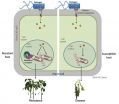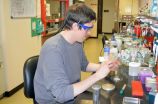(Press-News.org) Tropical rainforests have long been considered the Earth's lungs, sequestering large amounts of carbon dioxide from the atmosphere and thereby slowing down the increasing greenhouse effect and associated human-made climate change. Scientists in a global research project now show that the vast extensions of semi-arid landscapes occupying the transition zone between rainforest and desert dominate the ongoing increase in carbon sequestration by ecosystems globally, as well as large fluctuations between wet and dry years. This is a major rearrangement of planetary functions.
An international study released this week, led by Anders Ahlström, researcher at Lund University and Stanford University, shows that semi-arid ecosystems--savannahs and shrublands--play an extremely important role in controlling carbon sinks and the climate-mitigating ecosystem service they represent.
"Understanding the processes responsible for trends and variability of the carbon cycle, and where they occur, provides insight into the future evolution of the carbon sink in a warmer world and the vital role natural ecosystems may play in accelerating or slowing down human-induced climate change", says Anders Ahlström.
Tropical rainforests are highly productive, and this means that they take up a lot of carbon dioxide, but rainforests are crowded places with little room to fit in more plants to do more photosynthesis and to store carbon. In addition, the typical moist, hot weather conditions are ideal for growth and do not change much from year to year.
In savannahs it is different. As productivity increases there is room to fit in more trees whose growing biomass provides a sink, or store, for carbon sequestered from the atmosphere. In addition, savannahs spring to life in wetter years, causing large fluctuations in carbon dioxide uptake between wet and dry years. Large enough, Ahlström and colleagues show, to control the amount of carbon dioxide in the atmosphere.
"There has been an increase in the uptake of carbon dioxide over time, and land ecosystems have together absorbed almost one third of all carbon dioxide emissions from human activity since the 1960s. What is perhaps even more surprising is that this trend is also dominated by the semi-arid lands", Anders Ahlström says.
We have long known that we need to protect the rainforests but, with this study, the researchers show that a heightened effort is needed to manage and protect the semi-arid regions of the world as well.
"The world's semi-arid regions will become even more important in the future as climate variability and extremes increase in a warmer world", says the Australia-based researcher Josep G Canadell, director of the Global Carbon Project. "The extensive semi-arid regions of the world are emerging as a growing force in shaping the functioning of our planet", he continues.
"This study brings out clearly the importance of directing attention towards savannahs and other dry-climate ecosystems that have been largely neglected so far in climate policy discussions, and that moreover characterize the landscapes of some of the poorer countries of the Earth", says Benjamin Smith, Professor of Ecosystem Science at Lund University.
INFORMATION:
Contacts:
Anders Ahlström, Ecosystem Scientist, Department of Physical Geography and Ecosystem Science, Lund University, Sweden and Department of Earth System Science, School of Earth, Energy and Environmental Sciences, Stanford University, USA.
anders.ahlstrom@nateko.lu.se
+ 46 46-222 46 09
+ 46 73-202 84 87
Carbon cycle:
Carbon dioxide (CO2) exists naturally in the atmosphere, but it is also the greenhouse gas that is most altered by human activities, most notably fossil fuel combustion and tropical deforestation. The Earth's vegetation reduces the increase in atmospheric CO2 concentrations by sequestering over a quarter of anthropogenic emissions. This so-called carbon sink results from the balance between plant photosynthesis, which annually takes up a significant fraction of the CO2 in the atmosphere, and a slightly smaller quantity of CO2 that is released back to the atmosphere though life processes (respiration) and wild fires. The resultant carbon sink slows down the rate of increase of greenhouse gases in the atmosphere and helps mitigate global climate change, a vital ecosystem service.
(SACRAMENTO, Calif.) -- Researchers at UC Davis have conducted a comprehensive study to determine whether pediatric telemedicine consultations with rural emergency departments save money compared to telephone consults. The answer is a resounding yes. While telemedicine systems are expensive to install and maintain, they more than pay their way, saving an average $4,662 per use. The study was published in the journal Medical Decision Making.
"Our previous work showed that telemedicine was good for kids, families and providers, but we didn't really address the cost issue," ...
Lawrence Livermore researchers have determined that a tunnel bomb explosion by Syrian rebels was less than 60 tons as claimed by sources.
Using seismic stations in Turkey, Livermore scientists Michael Pasyanos and Sean Ford created a method to determine source characteristics of near earth surface explosions. They found the above-ground tunnel bomb blast under the Wadi al-Deif Army Base near Aleppo last spring was likely not as large as originally estimated and was closer to 40 tons.
Seismology has long been used to determine the source characteristics of underground ...
This news release is available in French. Montreal, May 21, 2015 - A new study published by the team of Naguib Mechawar, Ph.D., a researcher at the Douglas Institute (CIUSSS de l'Ouest-de-l'île-de-Montréal) and Associate Professor in the Department of Psychiatry at McGill University, suggests that the integration of new neurons in the adult brain is a phenomenon more generally compromised in the brains of depressed patients.
This new work confirms that neurogenesis in the human olfactory bulb is a marginal phenomenon in adults. These findings shed light ...
Alexandria, VA - In the years following the 1986 Chernobyl nuclear disaster, forest fires billowed plumes of contaminated smoke, carrying radioactive particles throughout Europe on the wind. Now, researchers fear that a shift to a hotter, drier climate in Eastern Europe could increase the frequency of these fires.
Researchers from the University of South Carolina in Columbia used satellite imagery of fires in the 2000s and field measurements of radioisotope levels to model changes in the distribution of radiation over the region. The researchers found that fires likely ...
Researchers have developed a model to assess how dams affect the viability of sea-run fish species that need to pass dams as they use both fresh and marine waters during their lifetimes. NOAA's Northeast Fisheries Science Center (NEFSC) and Greater Atlantic Regional Fisheries Office (GARFO) have partnered on this project to test how varying passage efficiency at dams related to survival rates for these species.
Using a model of endangered Atlantic salmon in Maine's Penobscot River as a case study, NOAA researchers found that abundance, distribution and number of fish ...
Hamilton, ON (May 21, 2015) - Scientists at McMaster University have discovered how to make adult sensory neurons from human patients simply by having them roll up their sleeve and providing a blood sample.
Specifically, stem cell scientists at McMaster can now directly convert adult human blood cells to both central nervous system (brain and spinal cord) neurons as well as neurons in the peripheral nervous system (rest of the body) that are responsible for pain, temperature and itch perception. This means that how a person's nervous system cells react and respond to ...
One of the reasons pluripotent stem cells are so popular in medical research is that they can be differentiated into any cell type. However, typical differentiation protocols lead to a heterogeneous population from which the desired type must be purified. Normally, antibodies that react to surface receptors unique to the desired cell are used for this purpose. However, in many cases the purification levels remain poor and the cells can be damaged. New RNA technology produced at CiRA may avoid these problems.
Professor Hirohide Saito at the Dept. of Reprogramming Science ...
Receptors carrying built-in decoys are the latest discovery in the evolutionary battle between plants and pathogens. The decoy domains within the receptor detect pathogens and raise the cell's alarm when there is an infection.
Plants display component parts of their immune system on receptors to trick pathogens into binding with them, which then triggers defence mechanisms. The discovery comes from Professor Jonathan Jones' group at The Sainsbury Laboratory, published in the high-impact journal Cell with a companion paper on a similar discovery from the Deslandes group ...
Almost 90 per cent of men with advanced prostate cancer carry genetic mutations in their tumours that could be targeted by either existing or new cancer drugs, a landmark new study reveals.
Scientists in the UK and the US have created a comprehensive map of the genetic mutations within lethal prostate cancers that have spread around the body, in a paper being hailed as the disease's 'Rosetta Stone'.
Researchers say that doctors could now start testing for these 'clinically actionable' mutations and give patients with advanced prostate cancer existing drugs or drug combinations ...
May 21, 2015 - A University of Wyoming faculty member led a research team that discovered a certain type of soil bacteria can use their social behavior of outer membrane exchange (OME) to repair damaged cells and improve the fitness of the bacteria population as a whole.
Daniel Wall, a UW associate professor in the Department of Molecular Biology, and others were able to show that damaged sustained by the outer membrane (OM) of a myxobacteria cell population was repaired by a healthy population using the process of OME. The research revealed that these social organisms ...

